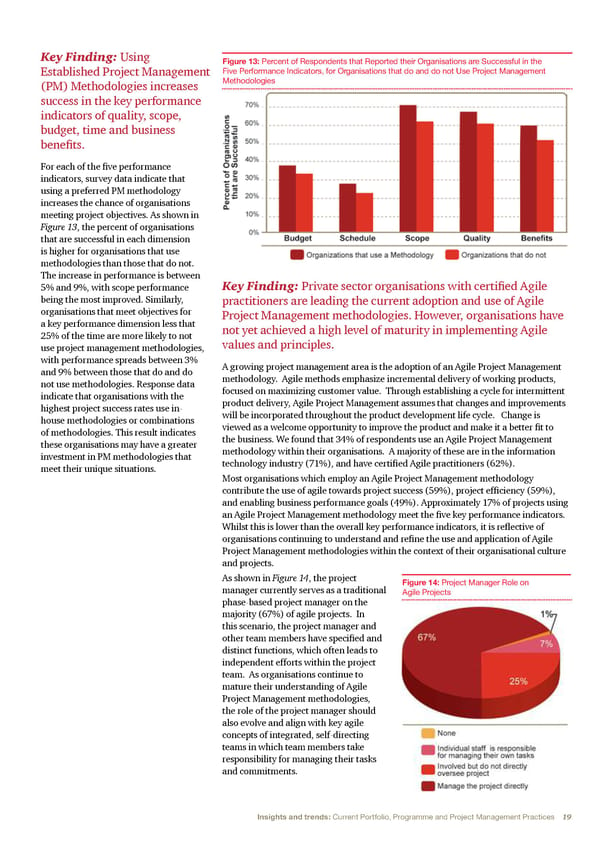Key Finding: Using Figure 13: Percent of Respondents that Reported their Organisations are Successful in the Established Project Management Five Performance Indicators, for Organisations that do and do not Use Project Management (PM) Methodologies increases Methodologies success in the key performance indicators of quality, scope, budget, time and business benefits. For each of the five performance indicators, survey data indicate that using a preferred PM methodology increases the chance of organisations meeting project objectives. As shown in Figure 13, the percent of organisations that are successful in each dimension is higher for organisations that use methodologies than those that do not. The increase in performance is between 5% and 9%, with scope performance Key Finding: Private sector organisations with certified Agile being the most improved. Similarly, practitioners are leading the current adoption and use of Agile organisations that meet objectives for Project Management methodologies. However, organisations have a key performance dimension less that not yet achieved a high level of maturity in implementing Agile 25% of the time are more likely to not values and principles. use project management methodologies, with performance spreads between 3% A growing project management area is the adoption of an Agile Project Management and 9% between those that do and do methodology. Agile methods emphasize incremental delivery of working products, not use methodologies. Response data focused on maximizing customer value. Through establishing a cycle for intermittent indicate that organisations with the product delivery, Agile Project Management assumes that changes and improvements highest project success rates use in- will be incorporated throughout the product development life cycle. Change is house methodologies or combinations viewed as a welcome opportunity to improve the product and make it a better fit to of methodologies. This result indicates the business. We found that 34% of respondents use an Agile Project Management these organisations may have a greater methodology within their organisations. A majority of these are in the information investment in PM methodologies that technology industry (71%), and have certified Agile practitioners (62%). meet their unique situations. Most organisations which employ an Agile Project Management methodology contribute the use of agile towards project success (59%), project efficiency (59%), and enabling business performance goals (49%). Approximately 17% of projects using an Agile Project Management methodology meet the five key performance indicators. Whilst this is lower than the overall key performance indicators, it is reflective of organisations continuing to understand and refine the use and application of Agile Project Management methodologies within the context of their organisational culture and projects. As shown in Figure 14, the project Figure 14: Project Manager Role on manager currently serves as a traditional Agile Projects phase-based project manager on the majority (67%) of agile projects. In this scenario, the project manager and other team members have specified and distinct functions, which often leads to independent efforts within the project team. As organisations continue to mature their understanding of Agile Project Management methodologies, the role of the project manager should also evolve and align with key agile concepts of integrated, self-directing teams in which team members take responsibility for managing their tasks and commitments. Insights and trends: Current Portfolio, Programme and Project Management Practices 19
 Insights and Trends Page 19 Page 21
Insights and Trends Page 19 Page 21